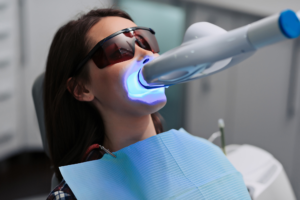
Many individuals value a bright, white smile, yet exposure to various foods will gradually discolor your teeth with time. Espresso, smoking, drink, and wine are just a few items that can change the color of your teeth. Teeth whitening, on the other hand, can restore the natural brightness of your teeth. People often fall for home-based treatments like rubbing your teeth with fruits or peels of fruits but it all could lead to more stains. So, you should avoid such practices at all costs.
There are indeed a variety of teeth whitening treatments and remedies in the industry, but there are still common misconceptions about how to whiten your teeth. Teeth whitening is much more difficult than expected, and it should only be done by a dentist. Teeth whitening is the process of removing discoloration from teeth and either returning them to their natural color or whitening them even further. Let’s know more about the facts of teeth whitening.
10 Facts about teeth whitening you should know:-
Teeth whitening toothpaste
Your teeth will look whiter if you use whitening toothpaste. It accomplishes this by eliminating discoloration on the enamel surface with granules or specific compounds that deteriorate or remove stains. When your teeth start to seem brighter, you need to use the toothpaste double a day for weeks to years. The toothpaste’s chemical forms a thin layer on your teeth, altering their look and creating the impression of whiter teeth.

It’s crucial to remember that no whitening toothpaste can remove significant stains that affect the appearance of your teeth color-wise.
Teeth are like sponges
Your teeth, like the skin or sponges, have pores. Anything colored you put colored out will seep into such pores. Wine, tea, dark fruits, and smoking all have a strong staining effect on teeth. Because of these stains, the natural color of your teeth darkens over time. Until you intentionally remove the stains, they will never go away. Teeth whitening gel that has been properly designed absorbs into your teeth and softly pushes stains out through the pores.
Teeth whitening is safe but not permanent
Almost everyone has encountered the notion that teeth whitening can harm your teeth, which is real if handled incorrectly. Teeth whitening is perfectly safe when performed by qualified specialists. It’s possible to go back to your normal routine once you’ve got your completely new shining smile. Darker foods and drinks, as well as smoke, could discolour your freshly whitened teeth, making your teeth look dull once more.
Sensitivity of teeth increases after teeth whitening
Numerous people have sensitive teeth, and experience an upsurge insensitivity whilst whitening is normal. Whenever the teeth become dehydrated as a result of the whitening treatment, they are unable to adequately shield the nerves from temperature fluctuations. The majority of sensitivity gains fade away around a day or two.
Not all teeth can be whitened to perfection.
The teeth’ color is determined at birth. As a result, few people’s teeth are inherently brighter than others. Teeth whitening will only eliminate stains that have built up over the years and therefore cannot change the color of your teeth’s underlying structure. As a result, you ought to be conscious of this when attempting to obtain that beautiful white smile, as it is not always achievable.
You might say it’s like following an unrealistic dream which will never come true! It is critical to recognize and accept that teeth are inherently yellow-ish in color. You can’t expect to have flawlessly white teeth for the rest of your life. Only use a teeth whitening technique if you wish to erase stains and discoloration that has developed unnaturally.
Brush your teeth before going to sleep at night
The spaces in your teeth open somewhat after whitening, making it simpler for stains to form. This is why it’s ideal to do your teeth whitening right before bedtime when you won’t be exposed to any potentially staining chemicals. Your teeth will organically rehydrate and realize while you sleep.
The effectiveness of teeth whitening is determined by the device used to provide the treatment.
You must choose the correct delivery device if you would like your teeth whitening process to be effective. Whereas most whitening treatments contain the same active chemicals, the equipment that is utilized has a bigger impact. A custom-fitted whitening tray would be utilized in a professional setting, as this is the most efficient and effective procedure. UV lights and whitening strips in contrast might be slow and unreliable.
Whitening caps and veneers are not possible.
Synthetic caps and veneers are made to match the color of your natural teeth whenever they are placed. It is impossible to change the color of the substance once it has been formed. Caps and veneers would not be lightened. Whitening your teeth will not harm your dental treatment.
Since no level of whitening is expected to modify the tint of dental crowns or veneers, many patients underwent procedures like porcelain veneers and dental implants to have their teeth lighten before surgery.
Understand that veneers and crowns can’t take on the physical qualities or attributes of teeth, no matter how realistic they are. Nevertheless, while porcelain is a stain-resistant material that can prevent staining, it cannot be whitened as effectively as genuine teeth.
Teeth Whitening Doesn’t Happen Overnight
Regardless of the procedure or approach you pick, keep in mind that teeth whitening takes patience. Fast-acting methods or products are frequently unreliable and contain chemicals that are harmful to your teeth.
Active ingredient of bleach whitening is hydrogen peroxide/Carbamide peroxide
The most common form of teeth whitening is professional bleaching, which can lighten your Enamel from its original color. Hydrogen peroxide or carbamide peroxide is frequently the ‘primary ingredient’ in the treatment. When the active ingredient is degraded, oxygen enters the enamel on the teeth, lightening the color.
